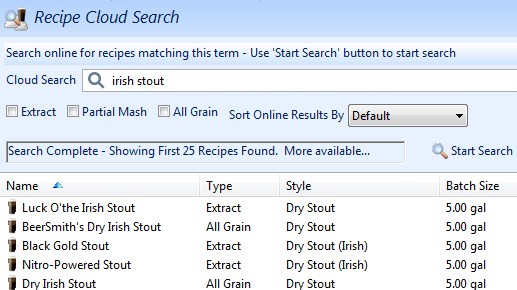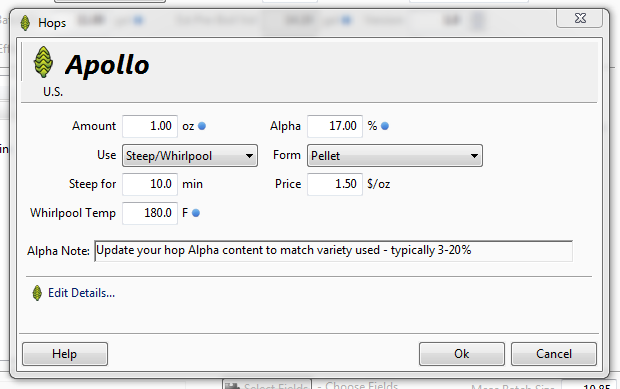

This lets you see the direct impact of a bit of gypsum on your water profile.
#BEERSMITH KEY SOFTWARE#
New BeerSmith 3 Water Profile and Mash FeaturesīeerSmith 3 is the only software with integrated water profile builder and mash pH estimation and adjustment built right in the recipe builder for all grain brewers. It's designed to make your brewing as easy to use as possible!īeerSmith 3 now includes support for mead, wine, and cider recipe types as well as native support for fruit, juice, and honey to make it easier than ever to build and track your favorite beverages in one tool.

Years in the making - BeerSmith 3 has been redesigned from the ground up to give it a modern look and feel with ribbons, themes, and tabbed browsing. Instantly search and access 10's of thousands of recipes on within the BeerSmith software.

Using modern yeast nutrient additions, any beer maker can make great mead at home in as little as 30-60 days.Design award winning beers with BeerSmith by matching the style and color of classic beers from around the world. The output from the program includes both the total and individual Fermaid-O or Fermaid-K additions as well as a description of when to add each, typically in four equal parts. For example the popular Lalvin 71B Narbonne yeast strain is a low nitrogen yeast strain. Most of the popular dry yeast strains are listed on the right in the calculator. After that it is simply a matter of choosing the method (TONSA or TiONSA) and then the yeast nitrogen requirements for your yeast strain. From the recipe builder these are calculated from your recipe and ingredient list. If you build a Mead recipe on the desktop version you can also go to the Starter tab in the open recipe for easier access as items like the OG and percent honey will be automatically calculated for you.įor the standalone tool you will need to enter your original gravity, percent honey and batch volume. You can go to Tools->Mead Nutrients on the desktop or mobile version or access it from a Gold+ account under Tools->Mead Nutrients after logging in at. You also may need to adjust for the percent of honey if using large fruit additions.īeerSmith 3 or higher also will do this calculation for you. This equation gives the total grams to add which is then divided into four equal additions to be added at 24, 48, 72 hours and at the 1/3 sugar break. Where the yeast factor is: Low=0.75, Med=0.9 and High=1.25 depending on the strain of yeast you are using.

Tot_grams_ferm_o = (Brix * 10 * batch_size_gals * yeast_factor)/50 The long form equation for calculating the TONSA addition is: Using inorganic DAP or Fermaid-K can lead to a faster fermentation up front, but also can lead to potential off flavors and aroma, so most mead makers have moved to the organic Fermaid-O TONSA method now. Some older nutrient schedules also use DAP (Diammonium Phosphate) as a nitrogen source. TiONSA is a slightly older method using the “inorganic” (and slightly cheaper) Fermaid-K nutrient. This method was popularized by the Mead Made Right blog. It uses Fermaid-O, which is an organic form of nitrogen as the main nutrient. TONSA 3.0 which stands for Tailored Organic Staggered Nutrient Addition is the most recent incarnation. The two most popular methods are TONSA and TiONSA. Lower gravity meads can be completed much faster. Using this technique, fermentation even on a high gravity mead can be completed in as little as two weeks, and the mead can be aged out and consumed in about 60 days. Typically these are added at 24 hours, 48 hours, 72 hours and then at either the 7 day mark or 1/3 sugar break (when 1/3 of the sugars have been fermented). The modern technique involves adding typically 4 nutrient additions at key points during early fermentation to provide the nutrients needed for a rapid and complete fermentation. Prior to the adoption of staggered nutrients, mead making was a very slow process, as it sometimes took up to a year for raw honey and water to fully ferment due to lack of nitrogen and other key nutrients. Staggered Nutrient AdditionsĪ key part of modern mead making techniques is the staggered addition of mead nutrients. I also explain the TiONSA and TONSA 3 models which are implemented in BeerSmith. This week we take a look at some alternative strategies for adding nutrients to your mead for proper fermentation.


 0 kommentar(er)
0 kommentar(er)
